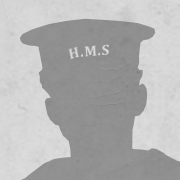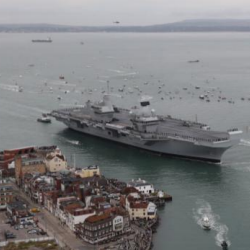
Ernest Benjamin Francis

Portsmouth
Port Detail
Decorations Messina Eartquake Medal. Naval Long Service Medal Next of kin address Agnes Morgan England More info Ernest Francis was one of a handful of survivors from HMS Queen Mary. He left a vivid account of his escape from X Turret and subsequent survival. "Then came the big explosion, which shook us a bit, and on looking at the pressure gauge I saw the pressure had failed. Immediately after that came what I term the big smash, and I was dangling in the air on a bowline, which saved me from being thrown down on to the floor of the turret; these bowlines were an idea I had brought into the turret, and each man in the gun-house was supplied with one, and, as far as I noticed, the men who had them on were not injured in the big smash. Nos. 2 and 3 of the left gun slipped down under the gun, and the gun appeared to me to have fallen through its trunnions and smashed up these two numbers. Everything in the ship went as quiet as a church, the floor of the turret was bulged up, and the guns were absolutely useless. I must mention here that there was not a sign of excitement. One man turned to me and said, "What do you think has happened?" I said "Steady everyone, I will speak to Mr. Ewart." I went back to the cabinet and said, "What do you think has happened, sir?" He said "God only knows." "Well, sir," I said, "it's no use keeping them all down here, why not send them up round the 4-inch guns, and give them a chance to fight it out. As soon as the Germans find we are out of action they will concentrate on us, and we shall all be going sky high." He said, "Yes, good idea. Just see whether the 4-inch guns aft are still standing." I put my head up through the hole in the roof of the turret, and I nearly fell back through again. The after 4-inch battery was smashed right out of all recognition, and then I noticed the ship had an awful list to port. I dropped back inside the turret and told Lieut. Ewart the state of affairs. He said, "Francis, we can do no more than give them a chance; clear the turret." "Clear the turret," I called out, and out they all went. P.O. Stares (Petty Officer T.H. Stares, 202884) was the last I saw coming up from the working chamber, and I asked whether he had passed the order to the magazine and shell room, and he told me it was no use, as the water was right up the trunk leading from the shell room, so the bottom of the ship must have been out of her. Then I said, "Why didn't you come up?" He simply said, "There was no order to leave the turret." I went through the cabinet and out through the top with the Lieutenant of the Turret following me; suddenly he stopped and went back into the turret. I believe he went back because he thought there was someone left inside. It makes me feel sore-hearted when I think of him and that fine crowd who were with me in the turret. I can only write about the splendid behaviour of my own turret's crew, but I am confident, knowing the Queen Mary as I did, that the highest traditions of the service were upheld by the remainder of the ship's company, from the Captain down to the youngest boy. Everyone was so keen on being in a big fight, and each member of our ship's company knew he was one of the small cog-wheels of a great machine; it was part of a man's training as laid down by our Gunnery Commander, and due to his untiring efforts to make the Queen Mary the splendid fighting unit I knew her to be. I was half-way down the ladder at the back of the turret when Lieutenant Ewart went back; the ship had an awful list to port by this time, so much so that men getting off the ladder went sliding down to port. I got on to the bottom rung of the ladder, but could not by my own efforts reach the stanchions lying on the deck from the starboard side. I knew if I let go that I should go sliding down to port like some of the others must have done, and probably get smashed up sliding down. Two of my turret's crew, seeing my difficulty, came to my assistance; they were A.B. Long, turret trainer, and A.B. Lane, No. 4 of the left gun. Lane held Long at full stretch from the ship's side, and I dropped from the ladder, caught Long's legs, and so gained the starboard side. These two men had no thought for their own safety; they saw I wanted assistance, and that was good enough for them. When I got on to the ship's side there seemed to be quite a fair crowd, and they did not appear to be very anxious to take to the water. I called out to them, "Come on, you chaps, who's coming for a swim?" Someone answered, "She will float for a long time yet," but something, I don't pretend to understand what it was, seemed to be urging me to get away, so I clambered up over the slimy bilge keel and fell off into the water, followed, I should think, by about five other men. I struck away from the ship as hard as I could, and must have covered nearly 50 yards, when there was a big smash, and stopping and looking round the air seemed to be full of fragments and flying pieces. A large piece seemed to be right above my head, and acting on an impulse I dipped under to avoid being struck, and stayed under as long as I could, and then came to the top again, when coming behind me I heard a rush of water, which looked very much like a surf breaking on a beach, and I realised it was the suction or back-wash from the ship which had just gone. I hardly had time to fill my lungs with air when it was on me; I felt it was no use struggling against it, so I let myself go for a moment or two, then I struck out, but I felt it was a losing game, and remarked to myself mentally, "What's the use of you struggling, you're done," and actually eased my efforts to reach the top, when a small voice seemed to say "Dig out." I started afresh, and something bumped against me. I grasped it, and afterwards found it was a large hammock; it undoubtedly pulled me to the top, more dead than alive, and I rested on it, but I felt I was getting very weak, and roused myself sufficiently to look around for something more substantial to support me. Floating right in front of me was a piece of timber (I believe the centre baulk of our pattern 4 target). I managed to push myself on the hammock close to the timber, and grasped a piece of rope hanging over the side. My next difficulty was to get on top, and I was beginning to give up hope, when the swell lifted me nearly on top, and with a small amount of exertion I kept on. I managed to reeve my arms through a strop, and then I must have become unconscious."

